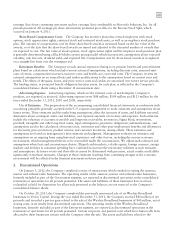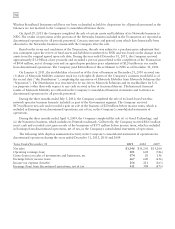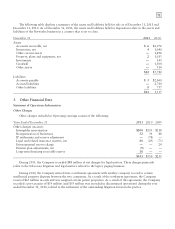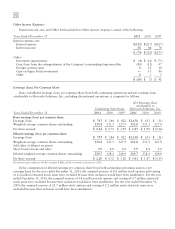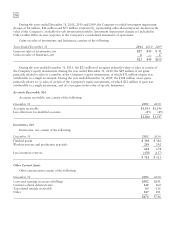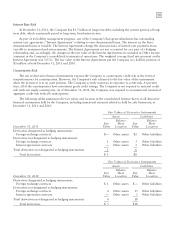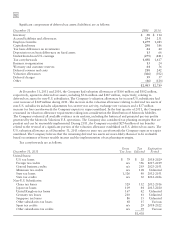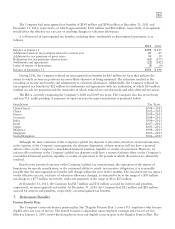Motorola 2011 Annual Report Download - page 84
Download and view the complete annual report
Please find page 84 of the 2011 Motorola annual report below. You can navigate through the pages in the report by either clicking on the pages listed below, or by using the keyword search tool below to find specific information within the annual report.
78
At December 31, 2011, the commitment fee assessed against the daily average unused amount was 25 basis
points.
5. Risk Management
Derivative Financial Instruments
Foreign Currency Risk
The Company uses financial instruments to reduce its overall exposure to the effects of currency fluctuations on
cash flows. The Company’s policy prohibits speculation in financial instruments for profit on exchange rate price
fluctuations, trading in currencies for which there are no underlying exposures, or entering into transactions for any
currency to intentionally increase the underlying exposure. Instruments that are designated as part of a hedging
relationship must be effective at reducing the risk associated with the exposure being hedged and are designated as
part of a hedging relationship at the inception of the contract. Accordingly, changes in the market values of hedge
instruments must be highly correlated with changes in market values of the underlying hedged items both at the
inception of the hedge and over the life of the hedge contract.
The Company’s strategy related to foreign exchange exposure management is to offset the gains or losses on the
financial instruments against losses or gains on the underlying operational cash flows or investments based on the
Company’s assessment of risk. The Company enters into derivative contracts for some of the Company’s
non-functional currency receivables and payables, which are primarily denominated in major currencies that can be
traded on open markets. The Company typically uses forward contracts and options to hedge these currency
exposures. In addition, the Company enters into derivative contracts for some forecasted transactions, which are
designated as part of a hedging relationship if it is determined that the transaction qualifies for hedge accounting
under the provisions of the authoritative accounting guidance for derivative instruments and hedging activities. A
portion of the Company’s exposure is from currencies that are not traded in liquid markets and these are addressed,
to the extent reasonably possible, by managing net asset positions, product pricing and component sourcing.
At December 31, 2011, the Company had outstanding foreign exchange contracts with notional amounts
totaling $524 million, compared to $1.5 billion outstanding at December 31, 2010 (of which $520 million related
to discontinued operations). Management believes that these financial instruments should not subject the Company
to undue risk due to foreign exchange movements because gains and losses on these contracts should generally offset
losses and gains on the underlying assets, liabilities and transactions, except for the ineffective portion of the
instruments, which are charged to Other within Other income (expense) in the Company’s consolidated statements
of operations.
The following table shows the five largest net notional amounts of the positions to buy or sell foreign currency
as of December 31, 2011 and the corresponding positions as of December 31, 2010:
Notional Amount
Net Buy (Sell) by Currency December 31,
2011
December 31,
2010
Chinese Renminbi $(283) $(423)
British Pound 55 187
Japanese Yen 46 40
Malaysian Ringgit 37 64
Brazilian Real (34) (43)
Income representing the ineffective portions of changes in the fair value of cash flow hedge positions were
immaterial amounts for years ending December 31, 2011 and December 31, 2010, and were included in Other
within Other income (expense) in the Company’s consolidated statements of operations.
At December 31, 2011, the maximum term of derivative instruments that hedge forecasted transactions was
12 months. The weighted average duration of the Company’s derivative instruments that hedge forecasted
transactions was five months.



